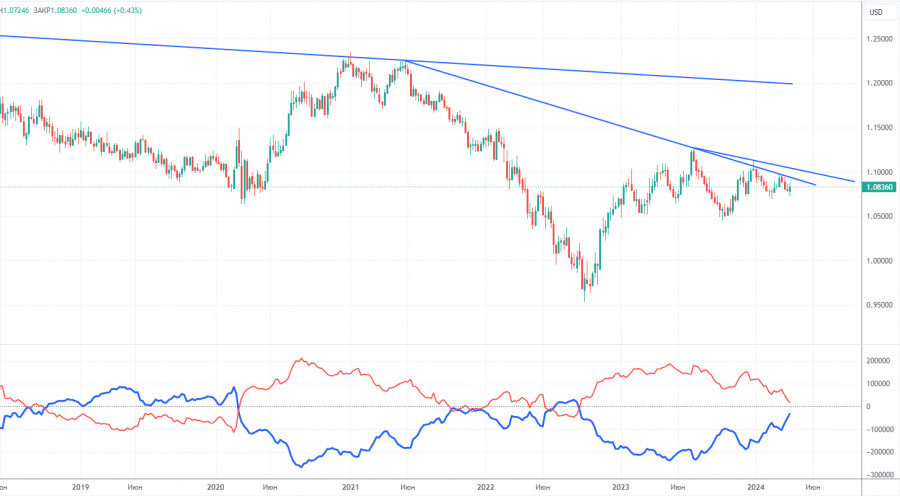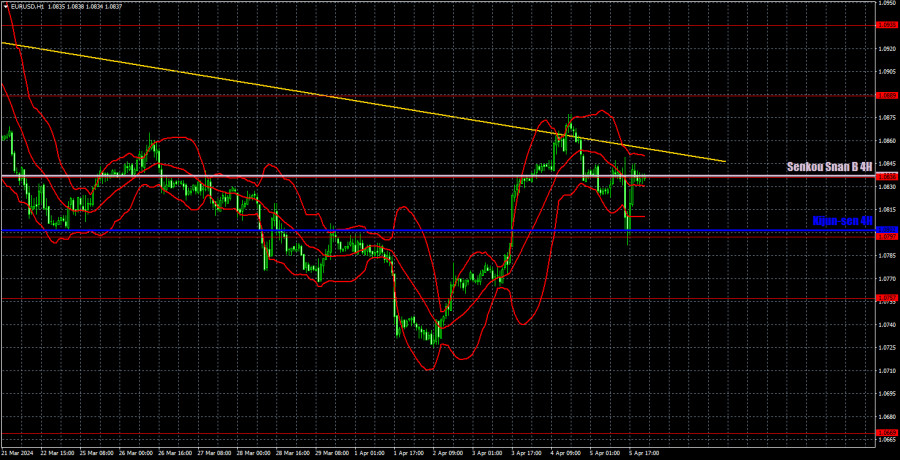Analysis of EUR/USD 5M

EUR/USD tried to start a logical downward movement on Friday. Especially when the reports on Nonfarm Payrolls and unemployment in the US were published. Both reports turned out better than forecasts, which should have boosted the dollar. And they did, but the greenback only strengthened for a short time. Basically, the dollar rose by 50 pips and then lost the same 50 pips in the next couple of hours. We understand why the dollar rose, but it is a mystery why it fell. Therefore, it is quite difficult to explain why the dollar did not show growth. Just like throughout the entire past week.
Take note that the majority of the crucial U.S reports turned out to be positive. Therefore, the dollar should have been rising for at least four out of five days. But once again, the market decided otherwise. The downtrend is formally maintained, as shown by the descending trendline, but the price is already above the critical line. The pair may start a downward movement this week, which could be a latemarket reaction to the U.S. reports, but everyone knows that the dollar should be rising even without help from these reports. The Federal Reserve may postpone the first rate cut from June to a later date, and the European Central Bank may lower rates as early as this week.
Speaking of trading signals, they were quite vague on Friday. Even during the European session, traders could open long positions, but they should have been closed before the release of the Nonfarm Payrolls. Then there was a rebound from the level of 1.0797, but it was quite difficult to expect the dollar to fall with such strong U.S. data. Unfortunately, that's exactly what we saw, so those who opened long positions could only earn a few dozen pips. Unfortunately, volatility was low again, despite a series of important reports.
COT report:

The latest COT report is dated March 26. The net position of non-commercial traders has been bullish for quite some time. Basically, the number of long positions in the market is higher than the number of short positions. However, at the same time, the net position of non-commercial traders (red line) has been decreasing in recent months, while that of commercial traders (blue line) has been increasing. This shows that market sentiment is turning bearish, as speculators increasingly sell the euro. Furthermore, we don't see any fundamental factors that can support the euro's strength, while technical analysis also suggests a downtrend. Three descending trend lines on the weekly chart indicate that there's a good chance of extending the decline.
At present, the red and blue lines are moving towards each other (indicating a trend reversal after a rise). Therefore, we believe that the euro will fall further. During the last reporting week, the number of long positions for the non-commercial group decreased by 2,200, while the number of short positions increased by 15,000. Accordingly, the net position decreased by 17,200. The number of buy contracts is higher than the number of sell contracts among non-commercial traders by only 31,000 (previously 48,000).
Analysis of EUR/USD 1H

On the 1-hour chart, the downtrend persists even if the price broke through the trend line for the second time, which could also turn out to be a false signal. EUR/USD is currently correcting higher, but the descending trendline continues to support sellers. The dollar should still rise in almost any case, as the overall fundamental background is on its side. The macroeconomic background also supports it, but the market practically ignored it last week.
On April 8, we highlight the following levels for trading: 1.0530, 1.0581, 1.0658-1.0669, 1.0757, 1.0797, 1.0836, 1.0889, 1.0935, 1.1006, 1.1092, as well as the Senkou Span B (1.0837) and Kijun-sen (1.0802) lines. The Ichimoku indicator lines can move during the day, so this should be taken into account when identifying trading signals. Don't forget to set a Stop Loss to breakeven if the price has moved in the intended direction by 15 pips. This will protect you against potential losses if the signal turns out to be false.
There are no important events scheduled on Monday. However, volatility remains moderate even with a strong macroeconomic background, and the pair is expected to show groundless movement. For now, the downtrend may still remain intact, but if the pair starts to rise on Monday, then anything can be expected regardless of news and reports.
Description of the chart:
Support and resistance levels are thick red lines near which the trend may end. They do not provide trading signals;
The Kijun-sen and Senkou Span B lines are the lines of the Ichimoku indicator, plotted to the 1H timeframe from the 4H one. They provide trading signals;
Extreme levels are thin red lines from which the price bounced earlier. They provide trading signals;
Yellow lines are trend lines, trend channels, and any other technical patterns;
Indicator 1 on the COT charts is the net position size for each category of traders;
The material has been provided by InstaForex Company - www.instaforex.comfrom Forex analysis review https://ift.tt/BXuO4zg
via IFTTT
